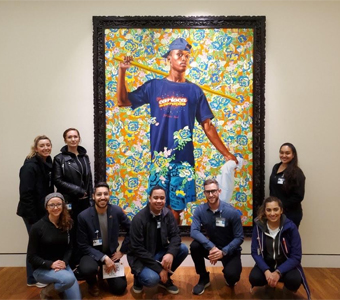Flash from the Past: How past experiences can shape future practice

In an effort to improve their visual literacy, PA21 looked outside the classroom for a lesson in observation. Curriculum led by Patrick Bowden, MMS, PA-C has aimed to improve students visual acumen through structured observation of artworks. Students spent an afternoon at the Portland Art Museum admiring works by the likes of Hank Willis Thomas. The curriculum is in its third year.
“One of my first patients presented acutely ill, cachectic and overwhelmed by a disseminated fungal infection. During this encounter, he was at times literally carried by his brother-in-law from the chair to the examination table. After identifying his underlying immune deficiency, we were able to begin treatment and the patient recuperated. His brother-in-law was struck by this transformation from frail, fragile and dependent - to healthy, strong, and stubborn. At a follow-up visit, his brother-in-law presented me with his most recent painting (I never knew he was painter). This painting revealed an emaciated figure with their ribs visible, a face that reminded me of Edvard Munch’s Scream, and flies circling about the head. My initial reaction was disgust and I turned my head. Next, the brother-in-law pointed to a beautiful butterfly that was perched on the dorsum of the hand in the painting. He reminded me that in the midst of decay and destruction that we have to look closer to find signs of transformation. He continued to explain that this painting represented my patient – ill, emaciated, dying and that due to medical intervention, he was able to transform back to health. Prior to this experience, I never considered a connection between medicine and art.
It was not until I transitioned to full-time educator, trying to find ways to teach students about observation that I returned to art. I stumbled upon the Art Institute of Chicago’s website and found a tour that focused on close looking. I recalled my previous experience in the exam room with art and began to consider my time in dermatology where my days were filled with looking for shapes, shadows and symmetry. I made a connection with Annie Morse, a curator and educator at the Art Institute and discovered a passion for connecting art with the art of medicine. Now in collaboration with the Portland Art Museum, I along with Hana Layton and Jill Lang, have been able to craft student experiences for looking at texture, shapes, color and symmetry at the museum. We will also return to the museum to consider the way a museum adapts experiences for visitors living with dementia or limited vision and how that can translate to modifications in our instructions or interactions clinically with patients. Lastly, we will return to the museum to confront grief, loss, and death. For many students in health professions, their first terms is a daily exploration centered around death as their first patient is a cadaver in the gross anatomy lab. Death is literally centered in this learning experience as the students surround the cadaver on the table. Our attempts to cure disease is only one component of what we do. The other side of that coin is healing. We hope to use the museum as a rehearsal hall for difficult conversations, beginning to embrace ambiguity, and learning from others as we navigate conversations around loss of a loved one, a dream, a relationship, or even our mobility. Initially, I did not see the connection between art and medicine – it took someone bringing art into the exam room. I want students to make the connection sooner than I did and to fully embrace their fully human, creative, emotional side, not merely their clinical gaze and fund of medical knowledge.”
The Close Looking experience is a program designed to guide professionals in using art as a way to hone skills in observation, communication, team-building, considering diverse perspectives, and tolerance of ambiguity through exercises and activities conducted in museum galleries. Studies have demonstrated an increase in visual literacy and observational skills among medical students after undergoing systematic training in observing and discussing fine art1. The desired outcome is translating these observational skills in art to the interaction with patients, resulting in a more thorough physical examination.
“I was surprised by the connection between our perception of art and the complicated patient interactions we have as PA students.” - Tom, PA21
Reference:
1. Naghshineh, S, Hafler JP, Miller AR, Blanco MA, Lipsitz SR, Dubroff RP, Khoshbin S, Katz JT. Formal Art Observation Training Improves Medical Students’ Visual Diagnostic Skills. J Gen Intern Med 23(7):991–7.